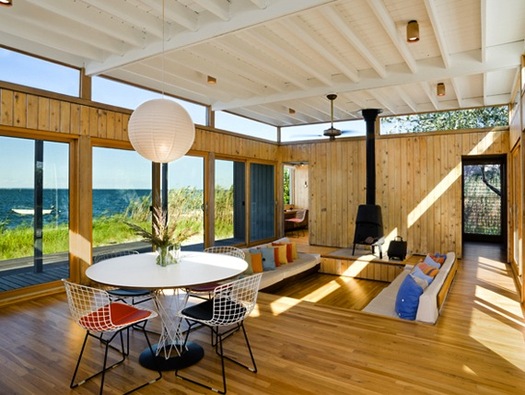
July 22, 2013
The Lost Architectural Muse of the AIDS Generation

Horace Gifford, Kauth House
It’s been hovering around 100 degrees all week up in New York, a muggy, close heat-wave that has just about everyone thinking about an escape from the concrete jungle to the beach, and a cool dip in the sea. It’s tempting to daydream: what would be the ideal beach house? Something informal. On the water. Open to the light and the air. Easy to maintain. Maybe a bit quirky in design. Comfortable but not overly luxurious, and with space to entertain.
That description works for me, and it encapsulates the philosophy of Horace Gifford, a sadly forgotten genius of the modern beach house, whose legacy has been recovered (really, discovered) by New York architect Christopher Rawlins.

Horace Gifford
Gifford built nearly eighty hoses, most of them on our near the beach of Fire Island, beginning in the early 1960s until his untimely death in 1992, a victim of the AIDS epidemic. Many of his clients were gay men, and his work was tailored to a gay lifestyle that was open, optimistic, and libertine. Here’s Rawlins, writing in his fine new biography/monograph of Gifford, Fire Island Modernist, on Gifford’s architectural and aesthetic philosophy:
In the car-free milieu of Fire Island, he choreographed a ritual of stepping down off of the public boardwalk, physically reconnecting with the landscape, and proceeding through a winding path before entering a home. He resisted fences. He left doors off closets to limit the stockpiling of possessions. He discouraged washers and dryers. He urged clients to tote little baskets of toiletries to the bathroom. He loathed painted surfaces, clipped lawns, and all of the brute force involved in tneding a typical suburban home. There was a conspicuous lack of accomodation for televisions. Bedrooms remained small to focus activity within the public spaces. Life in a Gifford home prescribed an arftul form of camping.
Architecturally, Gifford was something of a sponge. There are fairly blatant references to Philip Johnson, Andrew Geller, Richard Meier, and Charles Gwathmey in his catalog, but the Sarasota school work of Paul Rudolph looms as his greatest influence. Gifford, a Florida native, experienced that work early in life. However apparent these references, however, Gifford always managed to transform them into something uniquelyhis own.

Horace Gifford, Roeder House, fur-lined loft space.
Physical pleasure, broadly defined, was of paramount import to Gifford. (Rawlins titles a chapter “Form Follows Foreplay.”) Broad glass windows put bodies on display, and outdoor showers soaked them down. Conversation pits and fur-lined love nests and hidden terraces and towers were all designed with physical pleasure in mind. Certainly you don’t have to be gay to appreciate these spaces, but they were created for a gay culture, and the sensualism it celebrated.
The utter decimation of that culture, and the people who made it, is one of the great tragedies of our time. Credit Rawlins for bringing this small aspect of it back to life.
Observed
View all
Observed
By Mark Lamster
Recent Posts
A quieter place: Sound designer Eddie Gandelman on composing a future that allows us to hear ourselves think It’s Not Easy Bein’ Green: ‘Wicked’ spells for struggle and solidarity Making Space: Jon M. Chu on Designing Your Own Path Runway modeler: Airport architect Sameedha Mahajan on sending ever-more people skyward



